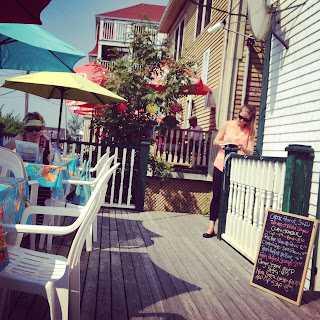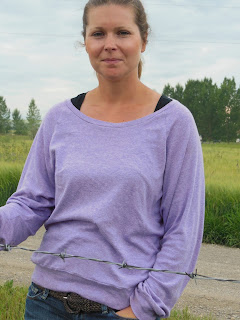This is the third theme that participants in this project have been asked to identify. What defines a "hero"? Google defines hero as one "who is admired for courage or noble qualities".
Madame Benoit comes to mind as her legacy was to educate one about food and preparation. In the early eighties, her TV shows geared to children focused on "Kids can Cook"! Her books were more than cookbooks as they also gave a history on the origins of recipes. Yet, Madame Benoit is unknown by the younger generation. Her legacy has not been promoted as Julia Childs was with the recent film of "Julie and Julia".
As Canadians we are a modest and humble bunch and not that eager to step forward to this recognization as "Hero". My approach was to find someone who is making a difference in producing sustainable food in Alberta.
Renee MacKillop from MacKillop Natural Highland Beef agreed to meet with me on her family farm.

The frist time, I saw Highland cattle was in Scotland by a castle gate. These beautiful animals were so photographed by tourists that they were not curious or acknowledge me even with much coaching.
On a overcast warm day last Thursday, I headed out to High River with husband and granddaughter Sophia to see the MacKillop's farm. With perfect directions to the farm, we drove to the bottom of the coulee, over a wooden bridge and turned into the road that snaked along Tongue Creek. We were so in awe of the landscape,we completely missed the cattle near the bridge.
Renee MacKillop greeted us and proudly showed us the horses who were being shod when we arrived.
The dogs were feasting on the trimming from the hoofs.
The excitement of a two year old who wanted to ride a horse quickly disappeared when she saw the size of the horse. Seeing a donkey that has a saddle for the little ones to ride, became a stand off between a disinterested donkey and a standoffish 2 year old.
Luke Skywalker the donkey
Renee walked me to the end of road where we had entered the farm to see some of their Highland cattle.
The MacKillop family has been farming in Alberta since 1920 when Renee’s grandfather bought the farm, Holiday Ranch, from the legendary rancher, Pat Burns. Later Donald Roderick, but everyone knew him as "Rod" purchasing native grassland on Pine Coulee near Nanton, AB where they raised their Scottish Highland cattle.
Highland is a distinct breed of cattle developed in Scotland that is much smaller than other breeds with a very unique look that sports long hair and horns. The Highland being one of the oldest purebred cattle breeds is extremely hardy for the cold north Atlantic coast of Scotland and has adapted well to the Alberta climate.
Renee, a university sociology graduate, joined her parents and Uncle Larry to farm and market the natural Highland beef through direct marketing to the public. Renee strongly believes this provides her with an ability to be part of something that is “environmentally sustainable and respectful of animal welfare” along with providing high quality and nutritious food for the family and their customers.
Although the use of modernizing technology is important in the marketing of their product and education of the public, the MacKillops have stayed true to traditional ways. They use horses to work the cattle and do not use antibiotics or growth hormones.
Working with a smaller number of cattle has the advantage of lower diseases due to the lack of need for feedlots for Highland Cattle. This results in less manure disposal problem leading to healthier animals without a need for antibiotics. Keeping the animals on a grass feed regimen leads to a more natural beef product.
When talking about natural Highland beef, Renee “really wants their customer to understand the land too.” By understanding that the cattle on the land helps in improving the soil quality and water retention, resulting in healthy natural beef which is high quality and nutritious.
Renee’s goal is to continue to promote and educate the public “to learn about nutritious food and sustainable farming and why natural, grass-fed meat is so important, not only for our individual health, but also for our environment”.
Renee works on the farm because she enjoys it and thinks it is an interesting way to make a living. She is able to be an entrepreneur and learn new things as well as challenge herself.
Renee is also a farmer because she believe that agriculture gives an opportunity to put environmentalism, health and community into action. She thinks that every person who choses to live by the values they believe in, make a difference because it inspires and enables other people with similar values to pursue them as well. Renee doesn’t think she is a hero, but has a lot of pride in the farm and in her family because they have worked hard work to make the farm a viable business and a beautiful place to live.
Although we did drive to see the larger herd of Highland cattle near Nanton, they were too far away in the rolling hills from us.
On our return home with a very over stimulated child from an adventure filled day in the country, I began to wonder how I would best feature this beautiful animal in a recipe.
Scotch eggs came to mind, but was quickly vetoed as by my son, protesting that no one really liked them when I last made them!
Having prepared this meat before I am aware that the meat is superior in taste, tenderness and cooking. I did find the taste to be more intense in flavor and needed to be cooked less due to the lower fat content.
Scientific tests carried out on Guaranteed Pure Highland Beef (GPHB) by the Scottish Agricultural College- the national College for Food, Land and Environmental Studies demonstrate convincing evidence that GPHB is significantly lower in Fat and Cholesterol and high in Protein and Iron than other beef.
Homemade Pizza with Beef, Caramelized Onions, Mushroom, Mozzarella and Gorgonzola Cheese
One onion, sliced
1/2 pound Highland ground beef
Fresh mushrooms, slice thinly
salt and pepper
red Chilli flakes
One pizza shell
Mozzarelle Cheese, shredded
Gorgonzola cheese, slices or chunks
|
Arugula and Truffle oil for garnish
Caramelizing the onions brings out the flavor of the onion. Slices of onions are slowed cooked on a low heat in olive oil until they turn golden brown by releasing the sugars in the onion. Watch closely by turning the onions over frequently as the onions can quickly burn. If the onions start to stick, add some water which will evaporate.
Spread the caramelized onion over the pizza shell.
Brown the ground beef until the pink is gone.
After tasting the cooked meat, I decide that this buttery delicious meat could stand on it own and only seasoned it with
salt and pepper with a handful of red chilli flakes.
Spread the browned ground beef over the caramelized onions.
Thin slices of Mushrooms were added as a layer to the pizza
Spread Mozzarella shredded cheese and slices of Gorgonzola cheese on top of the mushroom layer
Bake at 425 for 10- 15 minutes if pizza shell previous cooked, or 10 minutes more if the pizza shell is uncooked. The pizza can also be baked on the BBQ.
Garnish with Arugula and Truffle Oil
Home made Pizza Dough
1 Tablespoon of Traditional dry yeast
1 Tablespoon of sugar
2 cups of lukewarm water
4 - 5 cups of flour
1/4 cup of olive oil
Proof your yeast in the warm water and sugar for 10 minutes. You should see it fill with bubbles, then it's good to go! Test your water first before adding the yeast, use your wrist to test the temperature of the water as if the water is too hot, it will kill your yeast.
Start adding the flour, cup by cup, into the yeast mixture and mix with a large spoon until you can no longer mix it. Rub some olive oil into your hands and then work the dough along with some kneading until it all comes together.
Oil or grease a bowl, give a turn of your dough so it is well oiled, cover with plastic and a clean tea towel and let it double in size. Roll your dough very thinly.
You should get 2 - 13 inch pizza shells and one cookie sheet shell .. I usually precook my shells and freeze those not used for other meals.. In this case I dressed two pizza shell and froze one.
I plan to garnish the frozen pizza differently and will post pictures when I bake that pizza.

















































